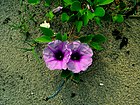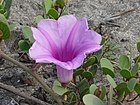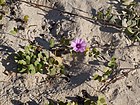Note: This is a project under development. The articles on this wiki are just being initiated and broadly incomplete. You can Help creating new pages.
Difference between revisions of "Ipomoea pes-caprae"
(→Photo Gallery) |
|||
| Line 59: | Line 59: | ||
<gallery class="left" caption="" widths="140px" heights="140px"> | <gallery class="left" caption="" widths="140px" heights="140px"> | ||
2 in the sea.jpg | 2 in the sea.jpg | ||
| + | |||
2017-01-26 Haemitahama,Iriomotejima,Okinawa 西表島南風見田浜 グンバイヒルガオ DSCF0641.jpg | 2017-01-26 Haemitahama,Iriomotejima,Okinawa 西表島南風見田浜 グンバイヒルガオ DSCF0641.jpg | ||
| + | |||
555594031 Taijiang National ParkCHIU,CHIH-CHENG 馬鞍藤-爭妍.jpg | 555594031 Taijiang National ParkCHIU,CHIH-CHENG 馬鞍藤-爭妍.jpg | ||
Atampu (Tamil- அடம்பு) (3228936526).jpg | Atampu (Tamil- அடம்பு) (3228936526).jpg | ||
Revision as of 12:49, 10 November 2020
Ipomoea pes-caprae is a very vigorous, creeping, or scrambling, evergreen, perennial plant with a large, thick root that can be 3 metres long and 5cm in diameter. With stems that can be 30 metres long and root at the nodes, the plant quickly forms a dense mat of low growth, completely covering the soil.
Contents
- 1 Uses
- 2 Parts Used
- 3 Chemical Composition
- 4 Common names
- 5 Properties
- 6 Habit
- 7 Identification
- 8 List of Ayurvedic medicine in which the herb is used
- 9 Where to get the saplings
- 10 Mode of Propagation
- 11 How to plant/cultivate
- 12 Commonly seen growing in areas
- 13 Photo Gallery
- 14 References
- 15 External Links
Uses
Dropsy, Urethral discharge, Ulcers, Rheumatism, Chicken pox, Skin ailments, Carbuncles, Swellings, Ulcers, Piles.[1]
Parts Used
Chemical Composition
Common names
| Language | Common name |
|---|---|
| Kannada | |
| Hindi | |
| Malayalam | |
| Tamil | |
| Telugu | |
| Marathi | |
| Gujarathi | |
| Punjabi | |
| Kashmiri | |
| Sanskrit | |
| English |
Properties
Reference: Dravya - Substance, Rasa - Taste, Guna - Qualities, Veerya - Potency, Vipaka - Post-digesion effect, Karma - Pharmacological activity, Prabhava - Therepeutics.
Dravya
Rasa
Guna
Veerya
Vipaka
Karma
Prabhava
Habit
Identification
Leaf
| Kind | Shape | Feature |
|---|---|---|
Flower
| Type | Size | Color and composition | Stamen | More information |
|---|---|---|---|---|
| {{{5}}} |
Fruit
| Type | Size | Mass | Appearance | Seeds | More information |
|---|---|---|---|---|---|
Other features
List of Ayurvedic medicine in which the herb is used
Where to get the saplings
Mode of Propagation
How to plant/cultivate
Requires a sunny position in a well-drained soil.[4]
Commonly seen growing in areas
Sandy dunes, Foreshores, Roadsides, Ditches.
Photo Gallery
References
- ↑ Indian Medicinal Plants by C.P.Khare
- ↑ [Chemistry]
- ↑ [Morphology]
- ↑ Cultivation
External Links
- Ayurvedic Herbs known to be helpful to treat Dropsy
- Ayurvedic Herbs known to be helpful to treat Urethral discharge
- Ayurvedic Herbs known to be helpful to treat Ulcers
- Ayurvedic Herbs known to be helpful to treat Rheumatism
- Ayurvedic Herbs known to be helpful to treat Chicken pox
- Ayurvedic Herbs known to be helpful to treat Skin ailments
- Ayurvedic Herbs known to be helpful to treat Carbuncles
- Ayurvedic Herbs known to be helpful to treat Swellings
- Ayurvedic Herbs known to be helpful to treat Piles
- Herbs with Leaves used in medicine
- Herbs with Roots used in medicine
- Habit - Evergreen perennial
- Index of Plants which can be propagated by Seeds
- Herbs that are commonly seen in the region of Sandy dunes
- Herbs that are commonly seen in the region of Foreshores
- Herbs that are commonly seen in the region of Roadsides
- Herbs that are commonly seen in the region of Ditches
- Herbs





